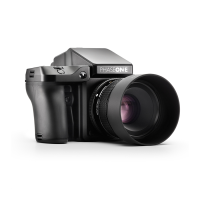119XF Camera System Manual |
Notices
©2017 Phase One A/S. All rights reserved. Made in Denmark.
User guide version: 1.95
Feature descriptions in this manual are referring to:
XF Camera System Feature Update 4 SR1 and Capture One 11
Colorspace images created in CROMiX ColorThink.
Photos by: Søren Jonesen (Photo+Co) and Carsten Esbensen
(Erik Bjørn & Kompagni)
Insert images by Alexander Flemming and Alexia Sinclair.
On Liability
The information in this manual is provided “as is”.
Under no circumstances, including negligence, shall Phase One be liable for any
incidental, special, direct, indirect or consequential damages arising out of or
relating to use of the information provided in this guide with or without the
software and/or hardware described in the guide.
Phase One reserves the right to change this documents information at any time
without prior notice.
All agreements, oral or written, based upon information within this document
will be null and void by the replacement or update of this document.
Trademarks and Acknowledgements
Capture One and Phase One are either registered trademarks or trademarks of
Phase One A/S in the European Union and/or other countries.
All other trademarks are the property of their respective owners.
This product includes DNG technology under license by Adobe Systems
Incorporated.
The Phase One IQ Digital Back firmware includes:
Libjpeg:
=========
This software is based in part on the work of the Independent JPEG Group.
zlib:
======
Interface of the ‘zlib’ general purpose compression library
Copyright (C) 1995-2012 Jean-loup Gailly and Mark Adler
This software is provided ‘as-is’, without any express or implied
warranty. In no event will the authors be held liable for any damages arising
from the use of this software.
Permission is granted to anyone to use this software for any purpose, including
commercial applications, and to alter it and redistribute it freely, subject to the
following restrictions:
1. The origin of this software must not be misrepresented; you must not
claim that you wrote the original software. If you use this software in a
product, an acknowledgment in the product documentation would be
appreciated but is not required.
2. Altered source versions must be plainly marked as such, and must not be
misrepresented as being the original software.
3. This notice may not be removed or altered from any source distribution.
Jean-loup Gailly Mark Adler
jloup@gzip.org madler@alumni.caltech.edu177
FCC Regulations:
§ 15.19 (a)(3)
This device complies with part 15 of the FCC Rules. Operation is subject to the
following two conditions: (1) This device may not cause harmful interference,
and (2) this device must accept any interference received, including interference
thatmay cause undesired operation.
§ 15.21
Changes or modifications not expressly approved by the party responsible for
compliance could void the user‘s authority to operate the equipment.
§ 15.105 (b)
This equipment has been tested and found to comply with the limits for a Class B
digital device, pursuant to part 15 of the FCC Rules. These limits are designed to
provide reasonable protection against harmful interference in a residential
installation. This equipment generates, uses and can radiate radio frequency
energy and, if not installed and used in accordance with the instructions, may
cause harmful interference to radio communications. However, there is no
guarantee that interference will not occur in a particular installation. If this
equipment does cause harmful interference to radio or television reception, which
can be determined by turning the equipment o and on, the user is encouraged
to try to correct the interference by one or more of the following measures:
• Reorient or relocate the receiving antenna.
• Increase the separation between the equipment and receiver.
• Connect the equipment into an outlet on a circuit dierent from that to
which the receiver is connected.
• Consult the dealer or an experienced radio/TV technician for help.
§ 15.407 (e)
Operation on the 5.15-5.25 GHz frequency band is restricted to indoor use only.
The FCC requires indoor use for the 5.15-5.25 GHz band to reduce the potential
for harmful interference to co-channel Mobile Satellite Systems.
§ 2.1093
RF Exposure Information (SAR)
This device is designed and manufactured not to exceed the emission limits for
exposure to radio frequency (RF) energy set by the Federal Communications
Commission of the U.S. Government. The exposure standard for wireless
devices employs a unit of measurement known as the Specific Absorption Rate
(SAR). The SAR limit adopted by the FCC is 1.6W/kg for an uncontrolled
environment. Tests for SAR are conducted using standard operating positions
accepted by the FCC with the device transmitting at its highest certified power
level in all tested frequency bands. The FCC has granted an Equipment
Authorization for this device with all reported SAR levels evaluated as in
compliance with the FCC.
IQ3 Digital Back FCC ID RYK WUBR507N
XF Camera contains Profoto Air Module FCC ID W4G-RMI
RF exposure guidelines.
Although the SAR is determined at the highest certified power level, the actual
SAR level of the device while operating can be well below the maximum value.
This is because the device is designed to operate at multiple power levels so as

